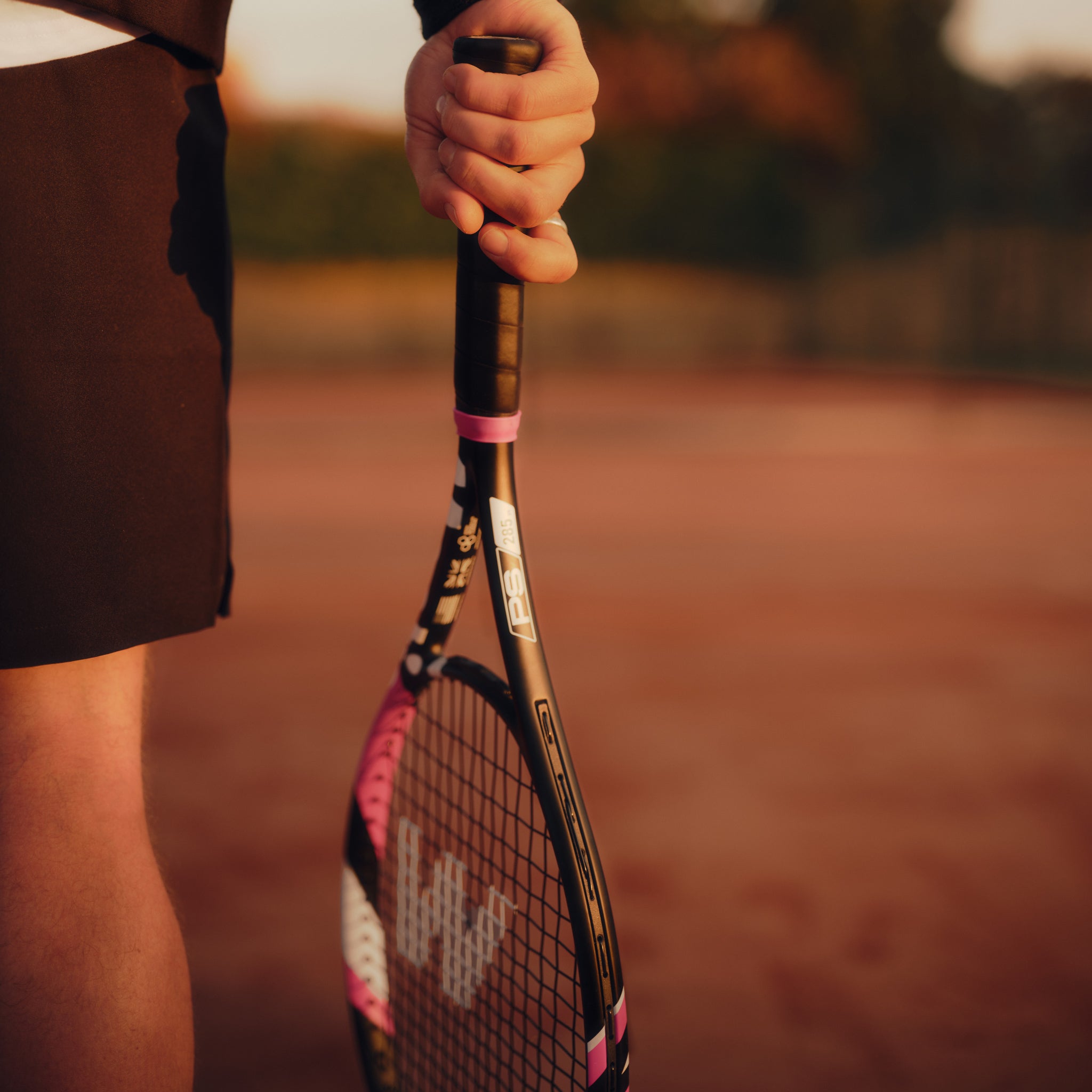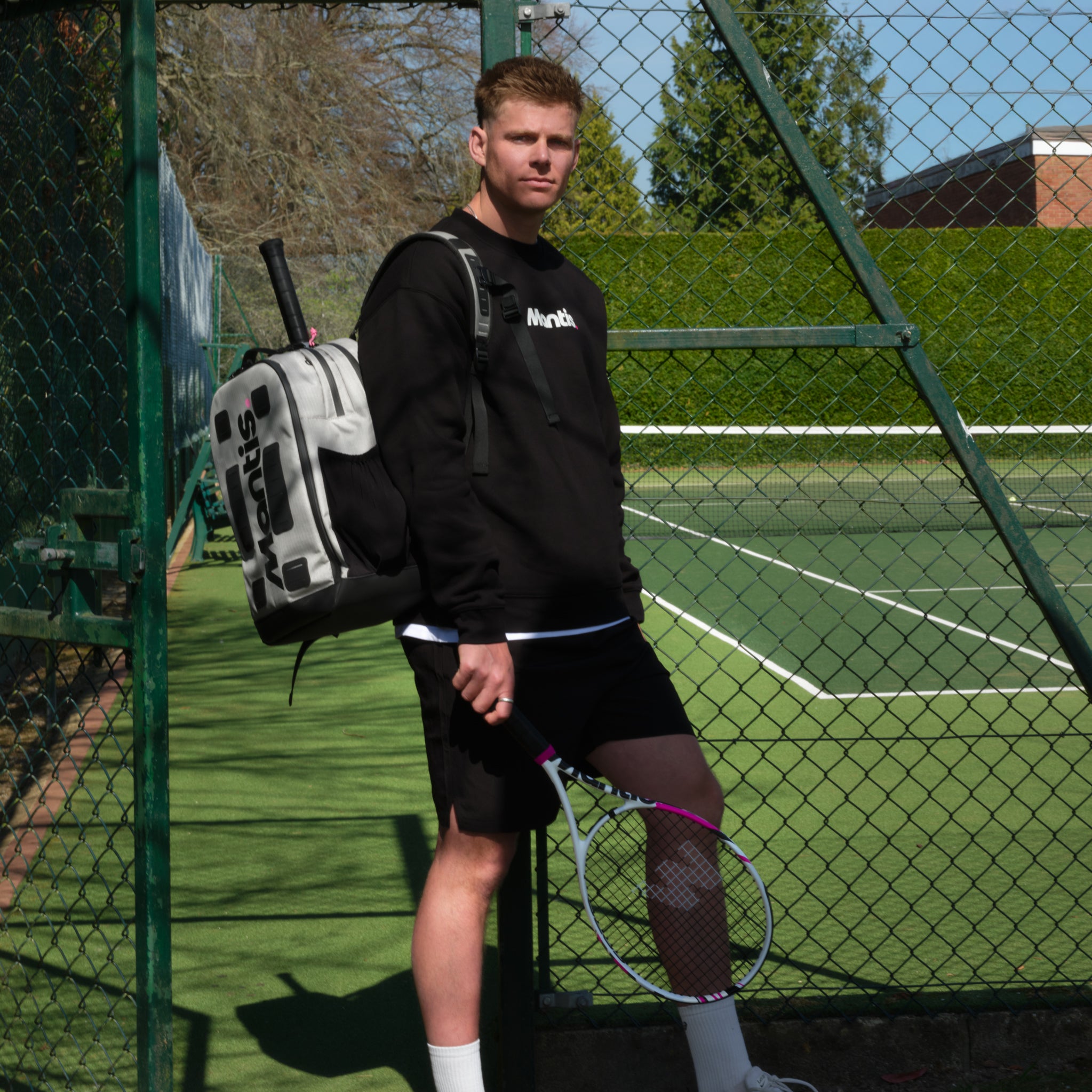
When you're dealing with that nagging pain of tennis elbow, a targeted exercise of tennis elbow programme is your best bet for a real, lasting fix. Focusing on gradual strengthening and stretching is the most proven way to heal the irritated tendon and stop the pain from coming back. While putting your feet up offers some temporary relief, it's active recovery that builds the resilience you need for the long haul, much like choosing the best tennis rackets for tennis elbow can support your game.
Understanding the Importance of a Structured Recovery
When that persistent ache in your elbow flares up, the first instinct for many is to stop moving the arm completely. It seems logical, right? But complete immobilisation can actually be counterproductive, often leading to stiffness and making the surrounding muscles weaker. At Mantis, we champion a smarter approach: a structured recovery plan that carefully balances rest with purposeful movement.
The goal isn't just to silence the pain for a week or two. It's about rebuilding the tendon's capacity to handle the demands of your life, whether that's serving an ace on the court or just carrying the shopping in.
This condition, clinically known as lateral epicondylitis, is far more common than people think. It affects roughly 1-3% of the UK population, hitting its peak in adults between 35 and 54 years old. And despite the name, it’s not just for tennis players; it frequently pops up in professions that require repetitive wrist motions, like carpentry or even long hours at a keyboard.
This visual guide breaks down the simple, effective flow for a smart recovery from tennis elbow.

As you can see, recovery is a progression. It moves from that initial, necessary rest phase into active strengthening, which is absolutely essential for getting results that last.
The Rationale Behind Active Rehabilitation During the Exercise of Tennis Elbow
So, why is exercise so vital? When a tendon is overused, its fibres become disorganised and weak. Think of it like a frayed rope. Smart, controlled exercise helps to realign these fibres and kickstart the production of collagen—the very protein that gives tendons their strength and structure. You're carefully repairing that frayed rope, thread by thread, instead of just shoving it in a drawer and hoping it mends itself.
A well-designed programme gets to the root of the problem by addressing several key areas:
- Pain Reduction: Gentle movements boost blood flow to the area. This helps to flush out inflammatory substances and deliver the nutrients needed for healing.
- Strength Building: Specific exercises, especially eccentric movements (where the muscle lengthens under load), are incredibly effective at rebuilding the tendon's integrity.
- Improved Flexibility: Stretching out those tight forearm muscles reduces the constant, nagging pull on the affected tendon at the elbow, which is often a major source of the strain.
- Functional Resilience: Ultimately, the goal is to get your arm ready for the demands of real life again, breaking that frustrating cycle of re-injury.
To make sure your exercise strategy is as effective as possible, it helps to understand the principles of building an effective personal training workout plan.
The core principle of tennis elbow rehabilitation is that tendons heal best under a controlled, progressive load. Avoiding movement entirely can actually weaken the tissue. In contrast, a strategic exercise of tennis elbow programme strengthens it, making it far more resilient to future stress.
This approach gives you a solid foundation for the specific routines we'll explore next. It transforms your recovery from a passive waiting game into an active, empowering process that puts you back in control.
Gentle Movements for Early Pain Relief
When your elbow is really flaring up, the last thing you want to do is push through the pain. At Mantis, our first step with players is always to calm things down. This initial phase is all about gentle, controlled movements designed to soothe that irritated tendon, reduce inflammation, and get some blood flowing to the area without adding any more stress.
Think of it as laying the groundwork. Before you can rebuild strength, you need a solid, pain-free foundation.
The focus here is on two things: isometric contractions and gentle range-of-motion exercises. A classic example is the isometric wrist extension. You’re essentially telling the forearm muscles to switch on without actually moving the wrist joint. It’s a brilliant way to start retraining those neuromuscular pathways without aggravating the tendon.
This first phase is so important because the loss of function can be quite stark. In the UK, it's common for tennis elbow patients to lose significant muscle strength in their wrist extensors. This weakness can slash pain-free grip strength by around 60% compared to the uninjured arm. That’s a huge drop that affects everything from holding a racket to picking up a kettle.
Interestingly, this weakness isn't always just on one side; it can be bilateral, hinting at broader changes in how the nervous system is controlling the muscles. For a deeper dive, Physio-pedia.com has some excellent insights on tennis elbow assessment.
Foundational Pain-Relief Exercises
To get started, find a comfortable spot to sit and rest your forearm on a table. The goal is complete support and control. Every movement should be slow, deliberate, and well within your pain-free limits. If you feel any sharp pain, stop immediately.
Here are a few gentle movements to begin with:
- Isometric Wrist Extension: With your palm facing down, use your other hand to apply light resistance to the back of your sore hand. Now, try to lift your hand up against that resistance, but don't actually let it move. Hold that gentle contraction for 5-10 seconds, relax, and repeat 10 times.
- Gentle Wrist Stretch (Flexion): Hold your sore arm out in front of you, palm facing the ceiling. With your other hand, gently bend your wrist downwards, pulling your fingers toward the floor until you feel a mild stretch in your forearm. Hold it there for 20-30 seconds.
- Pain-Free Range of Motion: With no weight at all, just slowly and smoothly move your wrist through its full range. Bend it up (extension), down (flexion), and gently from side to side. The movement should feel fluid and easy, never forced.
Here's a simple protocol to follow as you get started. The key is consistency and listening to what your elbow is telling you.
Phase One Gentle Exercise Protocol
This table outlines the starting point for your recovery, focusing on mobility and pain management.
| Exercise | Objective | Sets & Reps/Duration | Key Tip |
|---|---|---|---|
| Isometric Wrist Extension | Activate muscles without joint stress | 10 reps, 5-10 second holds | The pressure should be very gentle; think "waking up" the muscle, not challenging it. |
| Gentle Wrist Stretch | Improve flexibility and reduce tension | 2-3 reps, 20-30 second holds | Ease into the stretch. You're looking for a light pull, not a sharp pain. |
| Pain-Free Range of Motion | Restore mobility and promote blood flow | 10-15 slow, controlled reps | Keep the movements smooth and continuous. No jerky motions. |
Remember, this is just the beginning. The goal is to create a small, positive stimulus for healing.
The mantra for this phase is simple: "Listen to your body." These initial movements should bring a sense of relief and gentle activation, not strain. Pushing too hard, too soon is one of the most common recovery mistakes we see.
Managing Discomfort and Aiding Recovery
It’s normal to feel some mild muscle soreness as you reintroduce movement, and managing this is key to staying on track. Simple recovery techniques can make a world of difference.
Applying an ice pack for 10-15 minutes after your exercises can help calm any lingering inflammation. As you settle into this routine, other methods like using a sauna for sore muscles can be a great addition. The warmth can help relax the tight muscles around the elbow, improve circulation, and ease stiffness, perfectly complementing your active rehab work.
Building Tendon Strength with Eccentric Exercises
Once you’ve managed to calm down the initial inflammation, the real work begins. This is where we shift focus from pain relief to rebuilding, and at Mantis, we guide players into what is arguably the most effective phase of recovery: eccentric loading.
This phase is all about strengthening the tendon by making the muscle lengthen while it's under tension. It’s a proven method for stimulating healing and building the kind of resilience that prevents the pain from coming back. It’s also a good time to think about your gear—our guide to the best tennis rackets for tennis elbow can help make sure your equipment isn't working against your recovery.
This approach directly targets the disorganised, weakened tendon fibres that are causing all the grief. Think of it like carefully lowering a heavy box to the floor—your bicep lengthens under load to control the descent. That controlled lengthening is exactly what encourages the tendon fibres to realign and promotes the growth of healthy new tissue.
Mastering The Eccentric Wrist Extension
One of the cornerstone exercises for this is the eccentric wrist extension, and all you need is a light dumbbell. The key here isn't lifting heavy; it’s all about the slow, controlled lowering phase.
Here’s how you do it:
- Get Set: Sit at a table and rest your forearm on the surface, letting your hand hang off the edge with your palm facing down.
- Lift Passively: Hold a light dumbbell (a 1-2 kg weight is a great starting point). Use your uninjured hand to lift the weight up, extending your wrist. This is crucial—it ensures the sore arm does none of the lifting work.
- Lower Actively: Now, let go with your supporting hand. Slowly and deliberately lower the weight back down using only your injured arm. This movement should take a good 3-5 seconds. The slowness is what builds strength.
- Repeat: Aim for 2-3 sets of 10-15 repetitions each day.
This deliberate, controlled stress is the precise stimulus your tendon needs to remodel itself and get stronger.
The magic of eccentric exercise lies in its ability to load the tendon in a therapeutic way. It’s not about pushing through pain; it’s about applying a very specific, controlled force that encourages the body's natural healing and strengthening processes.
Introducing The Tyler Twist
Another fantastic tool-based exercise is the Tyler Twist. It uses a simple rubber bar called a FlexBar, and its unique twisting motion is perfect for isolating those extensor muscles.
- Grip and Extend: Hold the bar vertically in front of you with your injured hand, wrist extended so your knuckles point towards you.
- Twist and Lower: Grab the top of the bar with your other hand and twist it. Now, keeping that twist, extend both arms straight out in front of you.
- Controlled Release: This is the important part. Slowly untwist the bar by letting the wrist of your injured arm flex forward. That controlled release is the eccentric portion of the exercise.
A Note On Other Treatments
While targeted exercise is the gold standard for long-term recovery, it's worth knowing how it stacks up against other common treatments.
Corticosteroid injections, for example, can offer short-term relief, but physiotherapy is often favoured as a more effective and economical long-term solution. In fact, economic analyses from UK healthcare perspectives have led to guidelines that now tend to discourage the routine use of injections for tennis elbow, highlighting just how vital a solid exercise plan really is.
As you get stronger, remember that your equipment plays a huge role in preventing this from happening again. For any player wanting to understand the link between their gear and their health, exploring expert advice on how to select the best rackets and strings is time well spent.
Developing Functional Strength for Daily Life
Once you've built that foundational strength in the tendon, it's time to translate it into real-world resilience. At Mantis, we believe recovery isn't just about being pain-free; it's about making your arm strong enough for the demands of sport, work, and everyday life. This is where we bring in compound movements that teach your forearm, shoulder, and core to work together as a single, coordinated unit.
This shift from isolated exercises to functional strength is a game-changer. It’s the bridge between clinical rehab and simply living your life without fear of re-injury. You’re no longer just strengthening one muscle group; you’re training your entire kinetic chain to handle loads safely. This makes sure that the next time you lift a heavy shopping bag or hit a powerful backhand, your newly healed tendon isn't immediately overloaded. Part of this is also making sure your equipment is helping, not hurting—our guide on the best tennis rackets for tennis elbow is a great place to start.
Integrating Compound and Rotational Movements
To build this kind of practical power, we need to move beyond simple wrist curls. An exercise like the farmer's walk is perfect for this. Just holding a moderately heavy dumbbell or kettlebell in each hand and walking with good posture forces your grip, forearm, and shoulder to stabilise together. It's a simple move with profound benefits for building endurance.
We also need to get your rotational strength up to scratch. A lot of tennis elbow issues come from weakness in pronation (turning your palm down) and supination (turning your palm up).
- Resisted Supination: Sit with your elbow bent at 90 degrees, resting on a table. Hold a light dumbbell or a resistance band handle with your palm facing down. Slowly rotate your forearm to turn your palm upwards against the resistance.
- Resisted Pronation: In the same position, start with your palm facing up. Slowly rotate your forearm to turn your palm downwards.
These movements directly target the muscles controlling forearm rotation, which are crucial for everything from using a screwdriver to hitting a topspin forehand.
The whole point of functional exercise is to mimic the demands of your life. By integrating grip, shoulder, and core work, you create a robust support system for your elbow, massively reducing the risk of it happening again.
Knowing When You Are Ready to Progress
Moving into this more demanding phase requires you to be honest with yourself. Pushing too hard, too soon is a classic way to have a setback. You’re likely ready to bring in functional strength exercises when:
- You can complete your eccentric exercises (like the Tyler Twist) completely pain-free.
- Your general daily activities no longer trigger that familiar ache in your elbow.
- Your grip strength has noticeably improved and feels much more even when compared to your uninjured arm.
Once you can tick these boxes, you can start weaving these functional movements into your routine two to three times per week. Always start with light weights and be laser-focused on maintaining perfect form. The goal here is control and stability, not lifting the heaviest weight you can manage.
Your Long-Term Prevention and Maintenance Plan
Getting to a pain-free elbow is a huge milestone, but the real win is making sure it stays that way. At Mantis, we help players build a sustainable long-term plan that shifts recovery into genuine resilience. This means moving from a reactive mindset—treating pain when it flares up—to a proactive one where you build simple habits that keep your arm healthy for the long haul.
A smart maintenance routine doesn’t have to be complicated or time-consuming; it’s all about consistency. For a deeper dive into all the ways you can protect your elbow, check out our complete guide on how to prevent tennis elbow.
Creating Your Weekly Maintenance Routine
Think of your maintenance plan as a streamlined version of the exercises that got you back on court. The goal is to maintain the strength and flexibility you’ve built without spending hours on rehab every week. For most people, a simple but effective routine performed two to three times a week is all it takes.
Your routine should be a smart mix of strengthening and stretching:
- Strengthening: Keep doing those eccentric wrist extensions, maybe with a bit more weight or rolled into your regular gym session. Don't forget functional movements like farmer's walks—they're brilliant for maintaining overall grip and arm strength.
- Stretching: Make gentle wrist extensor and flexor stretches a regular habit, especially after playing or any activity that puts a strain on your forearms. Holding each stretch for 20-30 seconds is perfect for releasing tension before it has a chance to build up.
This is your arm's regular tune-up, keeping the muscles balanced and the tendons happy.
The most successful long-term outcomes are always seen in people who treat prevention as an ongoing practice, not a short-term fix. A few minutes of maintenance, a few times a week, is a tiny investment for staying active and pain-free.
Ergonomics and Technique Adjustments
Beyond specific exercises, how you use your arm day-to-day plays a massive role in stopping a recurrence. Overuse is the classic trigger for tennis elbow, so making small ergonomic adjustments at work or home can make a world of difference.
This could be as simple as changing your keyboard height to keep your wrists in a neutral position or making sure you take regular breaks from repetitive tasks like gardening or DIY.
For racket sport players, technique is everything. A tiny flaw in your backhand or serve can place huge, repeated stress on your elbow. Investing in a session with a qualified coach to analyse and refine your form is one of the best preventative steps you can take. They can help you generate power from your core and legs, taking the strain off your arm where it doesn't belong.
It’s also worth exploring how your equipment choices can help prevent injury. Gaining insights from industry resources like those at racketbusiness.com can be incredibly valuable for understanding the interplay between your gear and your body.
Common Questions About Tennis Elbow Exercises
Starting a new exercise routine for tennis elbow always brings up a few questions. At Mantis, we want to clear up any uncertainty so you can get on with your recovery feeling confident. Knowing what to expect is half the battle, and it's what keeps you showing up day after day—which is really the secret to getting better.
One of the first things we hear from players is, "Should these exercises hurt?" The answer is a definite no. You might feel a gentle stretch or the satisfying ache of a muscle working, but you should never, ever push into sharp or increasing pain.
Think of it on a scale of one to ten. Discomfort that’s a 2 or 3 out of 10 is probably okay, but anything more than that is your body telling you to back off. Remember, the goal here is to encourage healing, not to make the injury worse.
How Long Until I See Results?
This is the big one, and the honest answer is: it varies. Patience is your best friend here. Most people start to feel a bit of relief from their day-to-day pain within the first 2-3 weeks of doing these gentle exercises consistently. But that's just the start.
Building real, resilient strength in the tendon is a much longer game. You're looking at 6-12 weeks of dedicated work, especially with those eccentric exercises, to see significant, lasting change. It can feel slow, we know, but you are literally rebuilding tissue from the inside out. That just takes time.
The key is consistency over intensity. Doing the right exercises for tennis elbow gently every day is far more powerful than one aggressive workout a week. Small, regular efforts are what truly transform tendon health.
Another common question is about getting back on court. This has to be a slow and steady process. Once you’re completely pain-free doing your exercises and in your daily life, you can start to ease back into hitting.
Start with short, low-intensity sessions. See how your elbow feels the next day—that's the real test. And make sure your gear isn't contributing to the problem in the first place.
At Mantis, we believe your equipment should support your game, not hinder it. Our rackets are engineered to give you the precision and feel you need to play with confidence, without putting unnecessary stress on your arm. Find the right frame to aid your recovery and elevate your game at https://mantissport.com.










